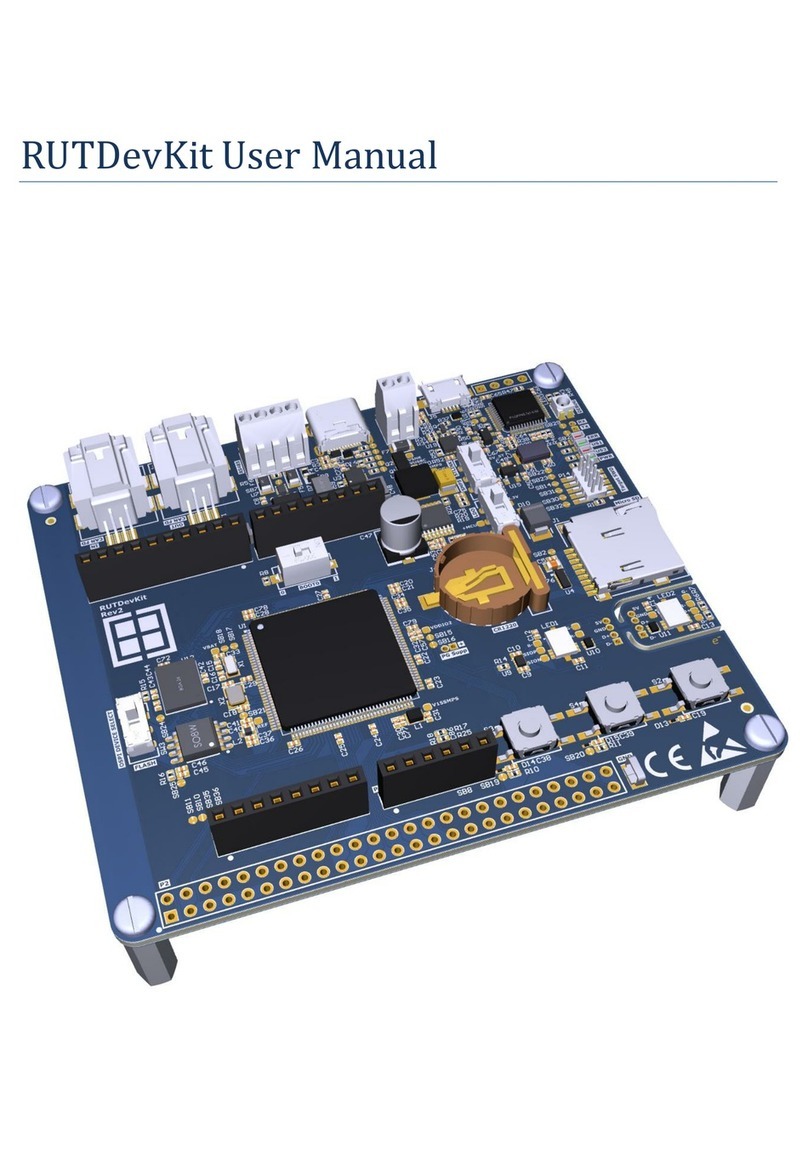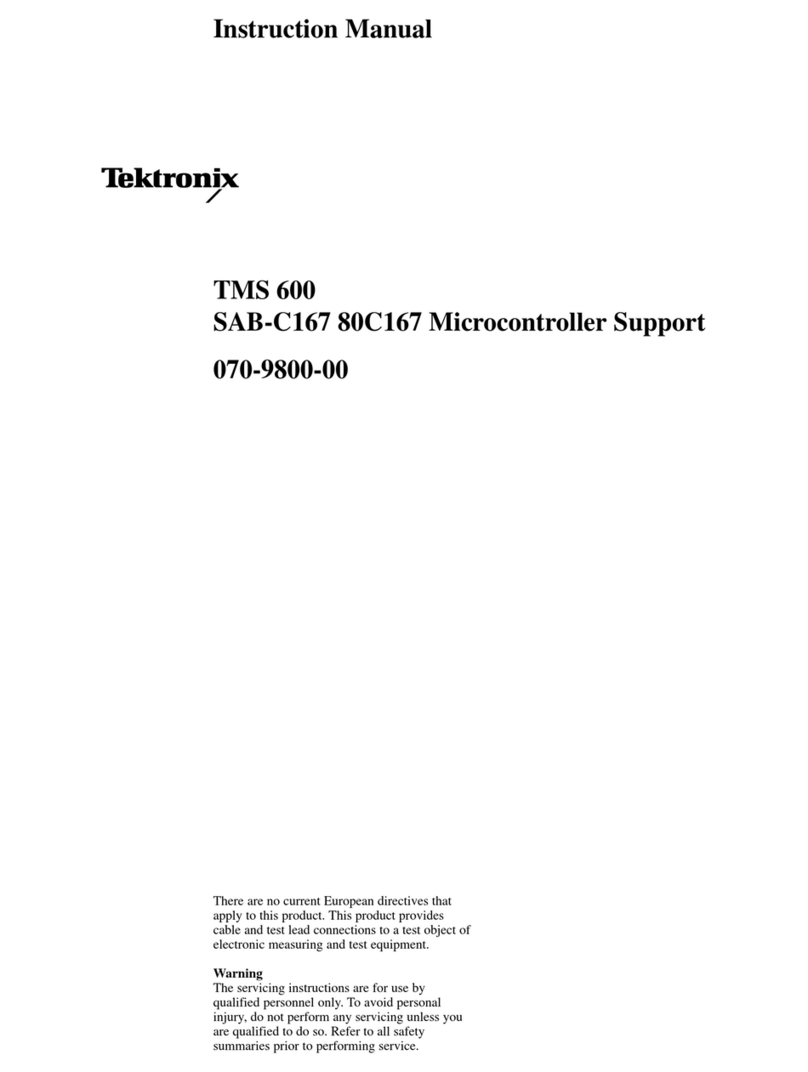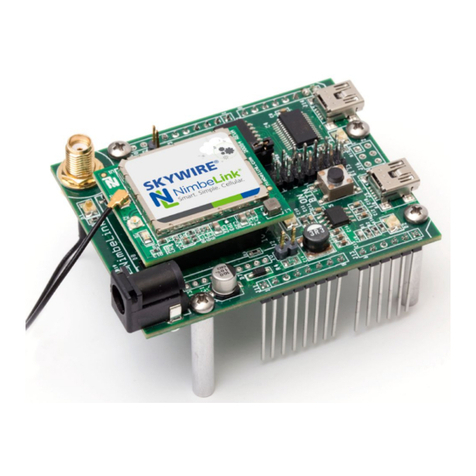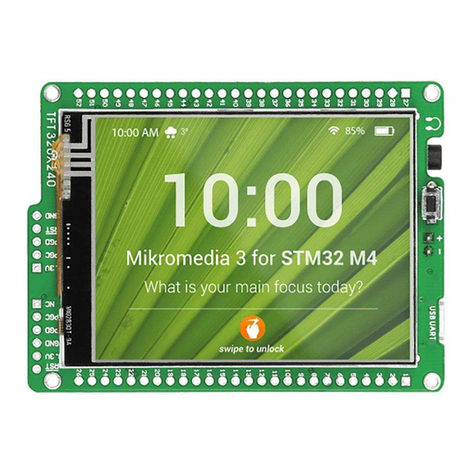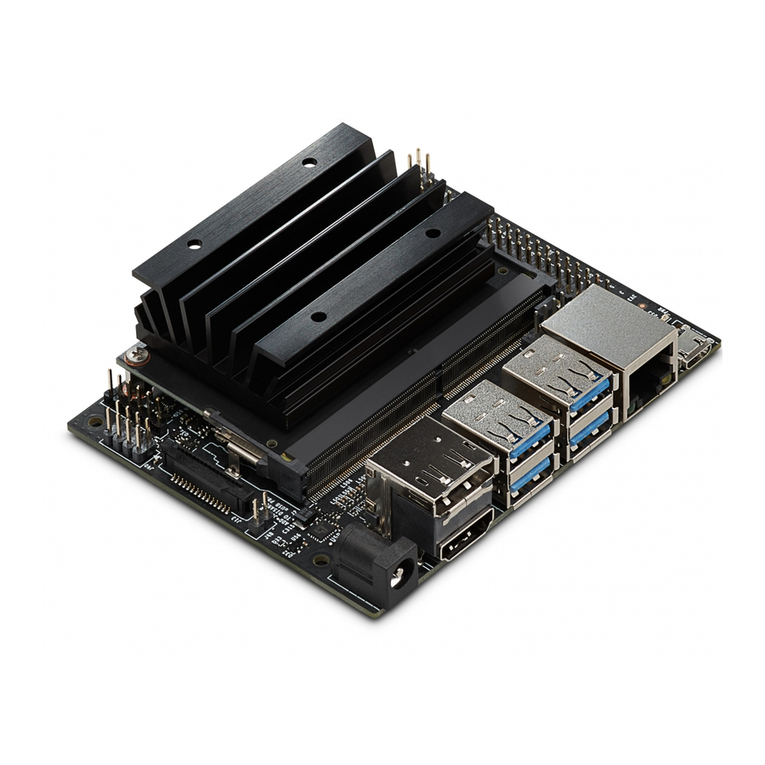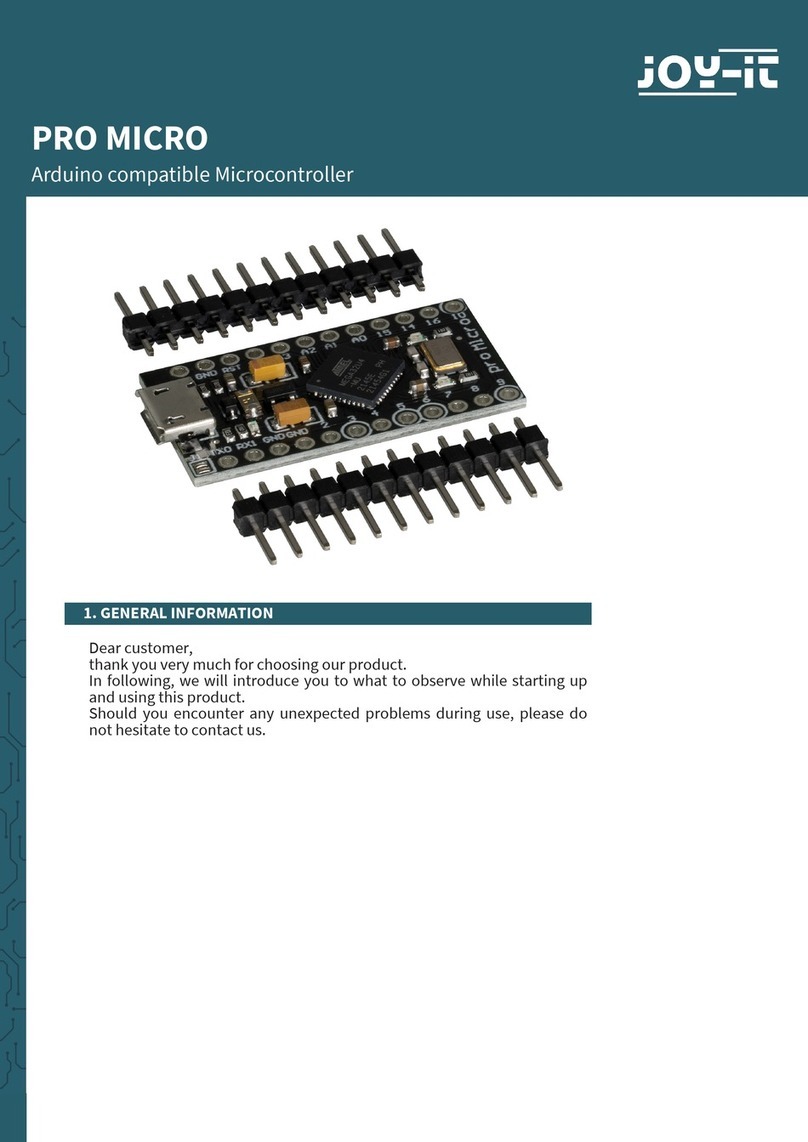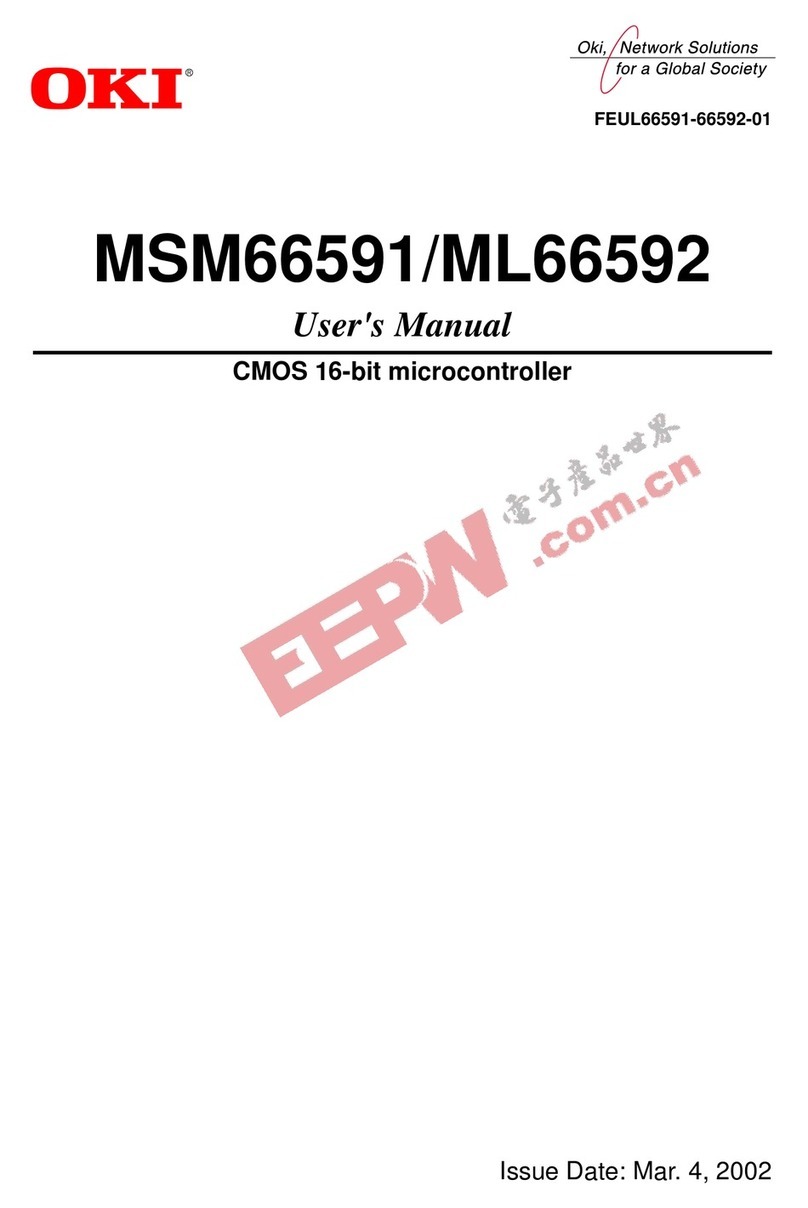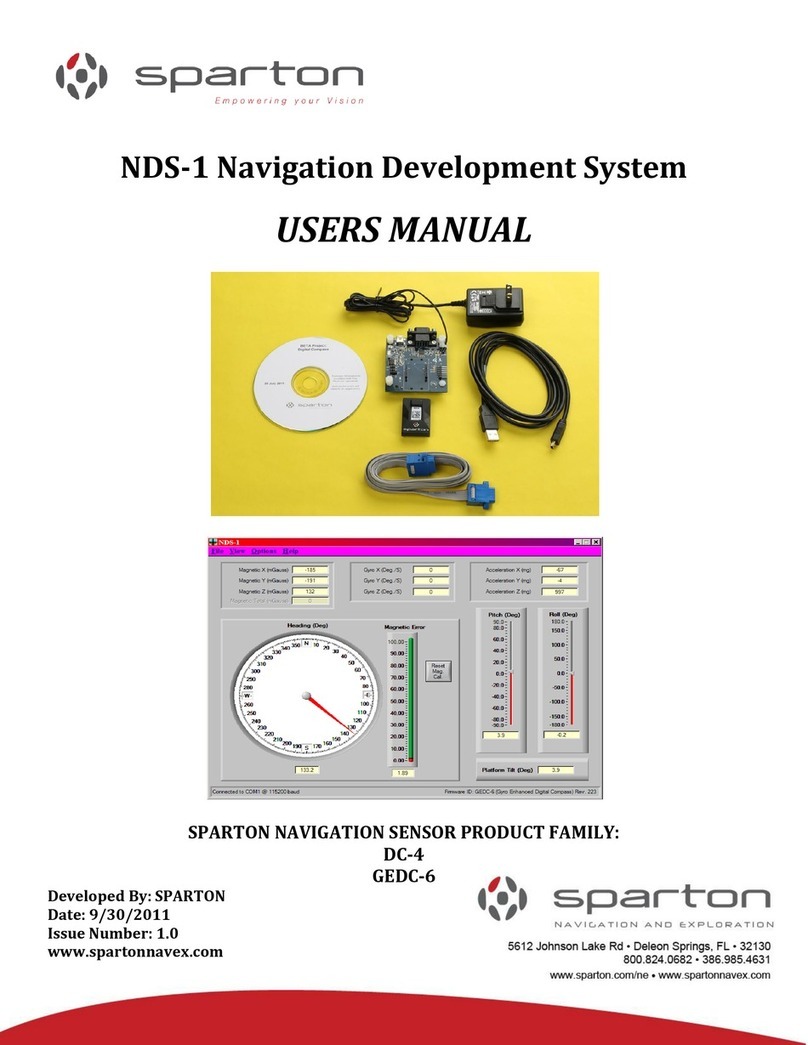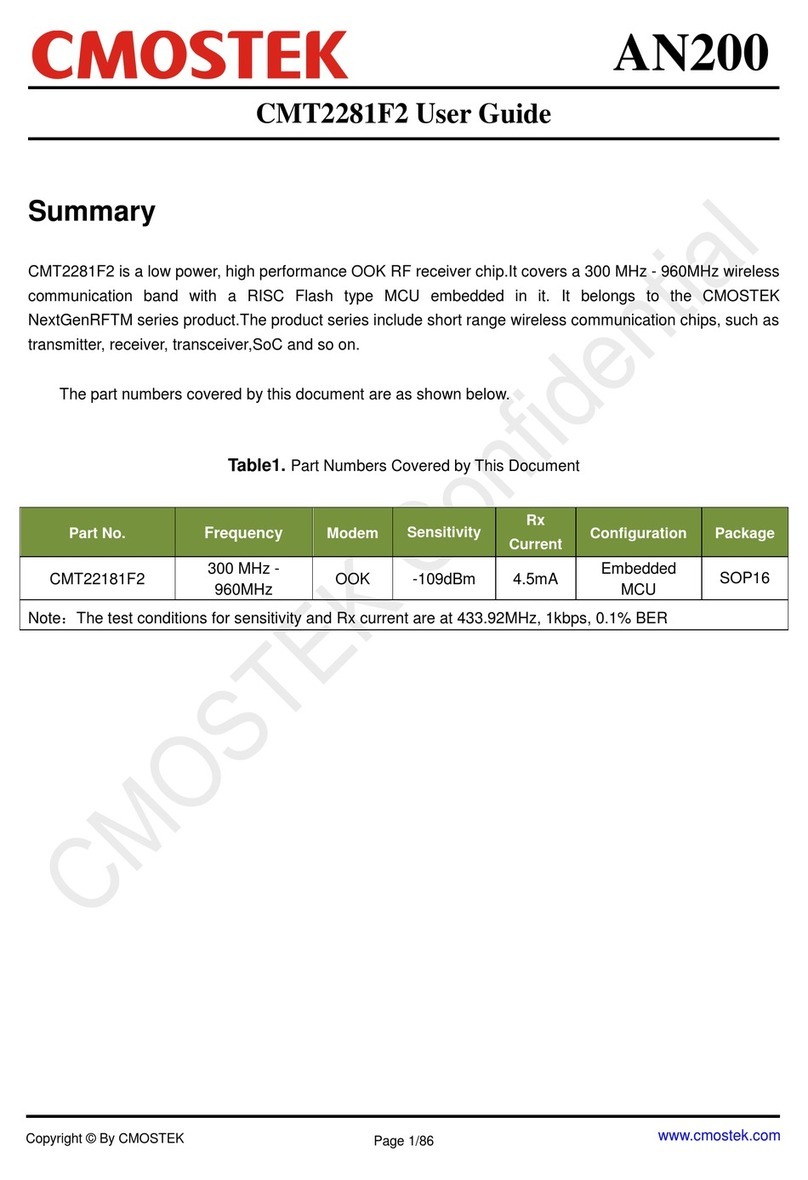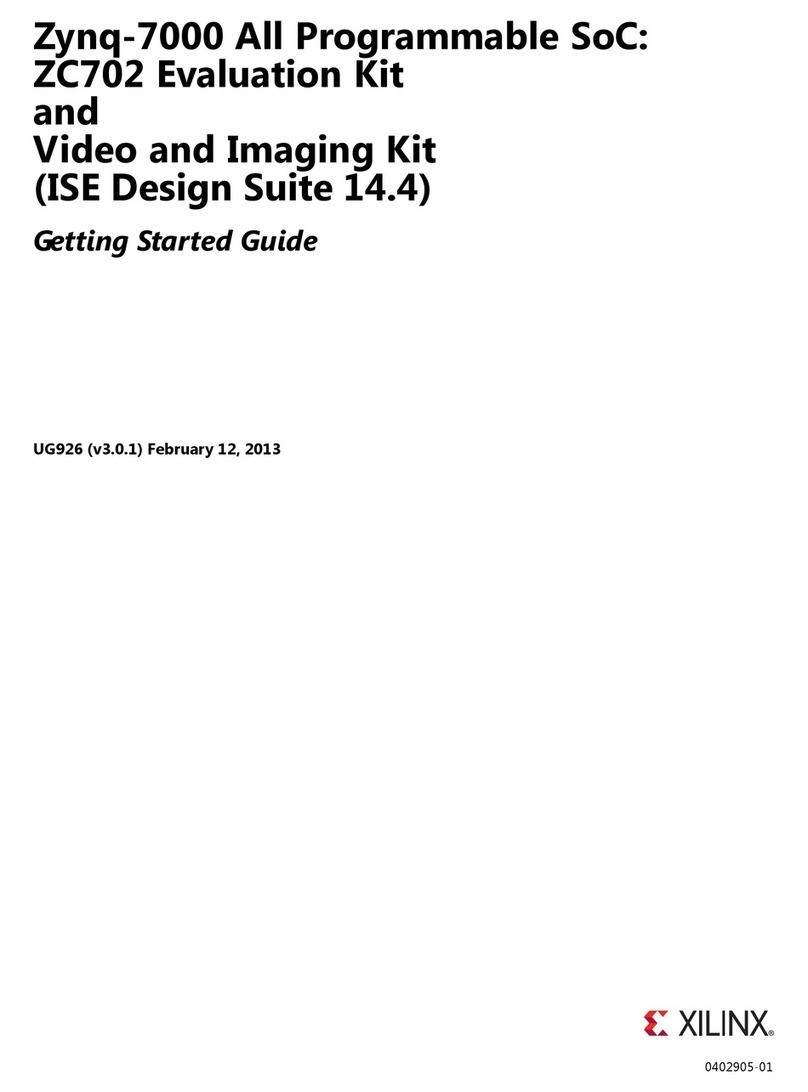Rohm Lapis EASE1000 V2 User manual

EASE1000 V2
User's Manual
3rd Edition
Issue Date: Mar. 23, 2020
FEXTEASE1000V2-03
LAPIS Semiconductor Co., Ltd.

NOTES
1) The information contained herein is subject to change without notice.
2) Although LAPIS Semiconductor is continuously working to improve product reliability and quality, semiconductors can
break down and malfunction due to various factors. Therefore, in order to prevent personal injury or fire arising from
failure, please take safety measures such as complying with the derating characteristics, implementing redundant and
fire prevention designs, and utilizing backups and fail-safe procedures. LAPIS Semiconductor shall have no responsibility
for any damages arising out of the use of our Products beyond the rating specified by LAPIS Semiconductor.
3) Examples of application circuits, circuit constants and any other information contained herein are provided only to
illustrate the standard usage and operations of the Products.The peripheral conditions must be taken into account when
designing circuits for mass production.
4) The technical information specified herein is intended only to show the typical functions of the Products and examples of
application circuits for the Products. No license, expressly or implied, is granted hereby under any intellectual property
rights or other rights of LAPIS Semiconductor or any third party with respect to the information contained in this
document; therefore LAPIS Semiconductor shall have no responsibility whatsoever for any dispute, concerning such
rights owned by third parties, arising out of the use of such technical information.
5) The Products are intended for use in general electronic equipment (i.e. AV/OA devices, communication, consumer
systems, gaming/entertainment sets) as well as the applications indicated in this document.
6) The Products specified in this document are not designed to be radiation tolerant.
7) For use of our Products in applications requiring a high degree of reliability (as exemplified below), please contact and
consult with a LAPIS Semiconductor representative: transportation equipment (i.e. cars, ships, trains), primary
communication equipment, traffic lights, fire/crime prevention, safety equipment, medical systems, servers, solar cells,
and power transmission systems.
8) Do not use our Products in applications requiring extremely high reliability, such as aerospace equipment, nuclear power
control systems, and submarine repeaters.
9) LAPIS Semiconductor shall have no responsibility for any damages or injury arising from non-compliance with the
recommended usage conditions and specifications contained herein.
10) LAPIS Semiconductor has used reasonable care to ensure the accuracy of the information contained in this document.
However, LAPIS Semiconductor does not warrant that such information is error-free and LAPIS Semiconductor shall
have no responsibility for any damages arising from any inaccuracy or misprint of such information.
11) Please use the Products in accordance with any applicable environmental laws and regulations, such as the RoHS
Directive. For more details, including RoHS compatibility, please contact a ROHM sales office. LAPIS Semiconductor
shall have no responsibility for any damages or losses resulting non-compliance with any applicable laws or regulations.
12) When providing our Products and technologies contained in this document to other countries, you must abide by the
procedures and provisions stipulated in all applicable export laws and regulations, including without limitation the US
Export Administration Regulations and the Foreign Exchange and Foreign Trade Act.
13) This document, in part or in whole, may not be reprinted or reproduced without prior consent of LAPIS Semiconductor.
Copyright 2018-2020 LAPIS Semiconductor Co., Ltd.
2-4-8 Shinyokohama, Kouhoku-ku,
Yokohama 222-8575, Japan
http://www.lapis-semi.com/en/
1

EASE1000 V2 User’s Manual
Table of Contents
CHAPTER 1 PREFACE...................................................................................................................4
For Safe and Correct Operation........................................................................................................................................5
Precautions........................................................................................................................................................................6
Description of Term..........................................................................................................................................................8
CHAPTER 2 GENERAL DESCRIPTION.......................................................................................9
2. General Description....................................................................................................................................................10
2.1 Product Overview .................................................................................................................................................10
2.2 EASE1000 V2 Components .................................................................................................................................11
2.3 Appearance ...........................................................................................................................................................12
2.4 Terms of Use.........................................................................................................................................................13
2.5 Target System Requirements................................................................................................................................14
CHAPTER 3 START......................................................................................................................19
3 START.........................................................................................................................................................................20
3.1 Starting EASE1000 V2.........................................................................................................................................20
CHAPTER 4 FUNCTIONS............................................................................................................22
4 Functions......................................................................................................................................................................23
4.1 On-chip debug function........................................................................................................................................23
4.2 Flash writer function.............................................................................................................................................23
4.3 Indicator................................................................................................................................................................23
CHAPTER 5 NOTES ON USE OF EASE1000 V2 ....................................................................25
5Notes on Use of EASE1000 V2.................................................................................................................................26
5.1 Notes on Debug ....................................................................................................................................................26
5.2 About the 3.3VOUT pin .......................................................................................................................................26
5.3 About Usage Environment....................................................................................................................................26
5.4 About Flash Writing .............................................................................................................................................27
5.5 About Cables.........................................................................................................................................................27
CHAPTER 6 APPENDICES ..........................................................................................................28
6. Appendices..................................................................................................................................................................29
6.1 Form information.................................................................................................................................................29
6.2 EASE1000 V2 Interface Cable Appearance........................................................................................................29
6.3 Update of Firmware.............................................................................................................................................30
2

EASE1000 V2 User’s Manual
Chapter 1 PREFACE
4

EASE1000 V2 User’s Manual
For Safe and Correct Operation
This user's manual uses various terms and pictorial indications for you to use this product safely and correctly and
to prevent harm to you and others and property damages. Their meanings and displays are as follows:
Meaning of term
Warning Incorrect handling in defiance of this display may cause death or
serious injury.
Note Incorrect handling in defiance of this display may cause injury or
property damage.
Example of pictorial indication
△記号は危険性の存在を知らせ、注意を促す内容があることを告げるものです。
図の中に具体的な注意内容(左図の場合は感電注意)が描かれています。
●記号は行為を強制したり、指示する内容を告げるものです。
図の中に具体的な指示内容(左図の場合は電源プラグをコンセントから抜いて下さい)が描
かれています。
○記号は禁止の行為であることを告げるものです。
図の中に具体的な指示内容(左図の場合は分解禁止)が描かれています。
△
symbol indicates a risk and calls attention. In the picture, a specific note ("Electric shock
hazard" in the left figure) is drawn.
●
symbol forces an action and indicates the instruction. In the picture, a specific instruction
("Disconnect the power plug from outlet" in the left figure) is drawn.
○
symbol indicates a banned action. In the picture, a specific instruction ("No decomposition"
in the left figure) is drawn.
5

EASE1000 V2 User’s Manual
Precautions
Be sure to read this page before using this product.
Warning
●Do not use the product at a voltage other than specified one.
It might cause fire, electric shock or failure.
●Do not remodeling the product.
It might cause fire, electric shock or failure.
●In case of an abnormal state such as reeking or abnormal odor, rapidly disconnect
the power plugs of EASE1000 V2 and any other external powers from outlet.
Leaving such situation as it might cause fire, electric shock or failure.
●Do not install the product in a wet or high-humidity environment.
It might cause fire, electric shock or failure.
●Do not place any object on the product.
It might cause fire, electric shock or failure.
●If you awake to any failure, use caution to rapidly disconnect the power plugs of
EASE1000 V2 and any other external powers from outlet.
Leaving such situation as it might cause fire or electric shock.
Note
●Do not place the product on an unstable or slope place.
It might cause falling and injury.
●Do not use the product in a place with excessive vibration, electromagnetical field,
or corrosive gas.
It might lead to loosened or disconnected connections of various cables, causing
fire, electric shock or failures.
●Do not use the product under out of the operational temperature, direct sunlight, or
dusty condition.
It might cause fire, electric shock or failure.
●Be sure to use the attached cables and accessories.
Other items might cause fire, electric shock or failure.
●Do not use the attached cables and accessories on other than this system.
It might cause fire, electric shock or failure.
6

EASE1000 V2 User’s Manual
Be sure to read this page before using this product.
Note
●Do not apply a voltage exceeding the 5.5V to the VTref pin of the EASE1000 V2
Interface cable. It might cause fire, electric shock or failure.
●The order of power ON and OFF needs extra attention. Incorrect order might cause
fire, electric shock or failure.
●Be sure to turn off the EASE1000 V2 and the user application system before
connecting or disconnecting them. Otherwise, it might cause fire, electric shock or
failure.
●The EASE1000 V2 is an unfinished product and intended for research and development and for
expert use in the research and development facility only.
The EASE1000 V2 is not intended for use for volume production or parts thereof.
●Do not use the EASE1000 V2 for the final check of target LSI of operation.
●The guarantee period to the initial failure of EASE1000 V2 is one year.
The obstacle by the wrong usage and reconstruction etc. cannot be guarantee.
●The content specified herein is subject to change for improvement without notice.
Therefore, when using the EASE1000 V2, the contents of the manual should check in the newest.
7

EASE1000 V2 User’s Manual
Description of Term
The following shows the terms used in this user's manual and their descriptions.
Term
Description
EASE1000 V2
It is an on-chip emulator for microcontroller of Lapis
Semiconductor.
It has a function as a writer (hereinafter referred to as flash
writer) to a LSI with built-in flash memory, as well as the
on-chip emulator function.
DTU8 debugger
It is software to control the on-chip emulator function of
EASE1000 V2 and is a Windows application running on the
PC.
MWU16 flash multi writer host program
It is software to control the flash multi writer function of
EASE1000 V2 and is a Windows application running on the
PC.
Target system
It is a board having a LSI to be debugged by EASE1000 V2 or
whose flash memory to be written or erased.
Host PC
It is a PC with the DTU8 debugger, MWU16 flash multi
writer host program, and USB driver installed.
USB cable
It is a cable to connect EASE1000 V2 with the host PC.
Target LSI
It is LSI debugged by EASE1000 V2.
EASE1000 V2 interface cable
It is an interface cable to connect EASE1000 V2 with the
target system.
8

EASE1000 V2 User’s Manual
Chapter 2 General Description
9

EASE1000 V2 User’s Manual
2. General Description
2.1 Product Overview
EASE1000 V2 is an on-chip emulator for Microcontroller (hereinafter referred to as target LSI) of Lapis
Semiconductor.
In combination with the DTU8 debugger, it provides the on-chip debug function.
Having the flash writer function as well, EASE1000 V2 can be used as a flash writer in combination with the
MWU16 flash multi writer host program.
Target LSI which can be used by EASE1000 V2 is ML62Q1000 series, ML610QXXX, and ML620QXXX.
Target system
Host PC
Target LSI
EASE1000 V2 interface cable USB cable
EASE1000 V2
・DTU8 Debugger
・MWU16 Flash Multi Writer
host program
Figure 2-1 EASE1000 V2 System Diagram
10

EASE1000 V2 User’s Manual
2.2 EASE1000 V2 Components
The following shows the EASE1000 V2 components.
Hardware
EASE1000 V2
Manuals
EASE1000 V2
USB cable
Accessories
Interface cable
This is the main component of EASE1000 V2 on-chip emulator.
User’s manual
Manual that describes the EASE1000 V2 on-chip emulator
(this manual)
EASE1000 V2
Cable used to connect the EASE1000 V2 on-chip emulator to a
host computer.
Cable used to connect the EASE1000 V2 on-chip emulator to a
Target system
Figure 2-2 EASE1000 V2 Components
11

EASE1000 V2 User’s Manual
2.3 Appearance
The following shows the appearance diagram of EASE1000 V2 and description of each part. In this description, a
component surrounded by brackets is the name printed on the case.
Figure 2-3 EASE1000 V2 Appearance (Top View)
- Target interface connector (TARGET)
A connector to connect EASE1000 V2 with the target system. Connect the supplied EASE1000 V2
interface cable.
- USB connector (USB)
A connector (Type-B mini) to connect EASE1000 V2 with the host PC. Connect the supplied USB cable.
- POWER indicator (POWER)
An LED to indicate the EASE1000 V2 state. It lights up or blinks in green.
For the relationship between the indicator light state and EASE1000 V2 state, see "4.3 Indicator".
- BUSY indicator (BUSY)
An LED to indicate the EASE1000 V2 state. It lights up or blinks in yellow.
For the relationship between the indicator light state and EASE1000 V2 state, see "4.3 Indicator ".
BUSY indicator
(BUSY)
POWER indicator
(POWER)
Target interface
connector
(TARGET)
USB connector
(USB)
12

EASE1000 V2 User’s Manual
2.4 Terms of Use
EASE1000 V2 should be used in an environment which meets the following conditions.
Terms of use for EASE1000 V2
Parameter
Description
Power supply
USB VBUS output (5 V, 500 mA) on the host PC
Usage environment
Temperature: 5 to 40 °C
Relative humidity: 30 to 80% (no condensation)
Target LSI
Positive power supply (VTref) voltage
Target LSI operation voltage
1.6 to 5.5 V
For an operating environment for software running on the host PC, see the following documents.
- DTU8 User's Manual
- MWU16 Flash Multi Writer Host Program User's Manual
When using EASE1000 V2 as an on-chip emulator or flash writer, the power supply output from EASE1000 V2 to
the target LSI is as follows:
Output power supply of EASE1000 V2
Parameter
Description
Power supply for target LSI
(3.3VOUT)
3.3 V (typ) / 100 mA (max)
Power supply for programming Flash
ROM (Vpp)
8V (max) / 10mA (max)
Positive power supply for internal logic
(VDDL)
When programming the Flash ROM : 2.80V (typ) / 20mA (max)
During other debug modes : 1.45V (typ) / 20mA (max)
-The power supply for the target LSI is output after debugging with target LSI by DTU8 debugger or when
MWU16 Flash Multi Writer Host Program is in a plug state.
-The power supply for programming Flash ROM (Vpp) is outputted while the DTU8 debugger or MWU16
Flash Multi Writer Host Program is programming the Flash ROM on the target MCU. (Note 1)
-The power supply for internal logic (VDDL) outputs 1.45V after starting the debug mode with target LSI by
the DTU8 debugger or while the MWU16 Flash Multi Writer Host Program is in a plug state.
Also, the EASE1000 outputs 2.80V while programming the Flash ROM on the target MCU by the DTU8
debugger or MWU16 Flash Multi Writer Host Program. (Note 1)
■Note 1■
EASE1000 V2 outputs the power supply for programming Flash ROM and the power supply for internal
logic only for target LSIs which need the power.
13

EASE1000 V2 User’s Manual
2.5 Target System Requirements
The target system connected with EASE1000 V2 must meet the following requirements.
Target System requirements
Item
Description
Interface connector
Must support the EASE1000 V2 interface cable
Must have a 14-pin 2.54 mm pitch connector
(Compatible connector: HIF3FC-14PA-2.54DSA)
Target LSI
Positive power supply (VDD)
voltage
1.6 to 5.5V (Note 1)
Power consumption (VTref)
10mA
■Note 1■
- Since the target LSI positive power supply is used for the internal circuit of EASE1000 V2, its power
consumption increases when EASE1000 V2 is in use.
Use an appropriate amount of the target system positive power supply while considering the power
consumed by EASE1000 V2.
- Do not connect EASE1000 V2 when measure the consumption current of a target system.
The on-chip debugging circuit in target LSI influences, and consumption current increases.
The following shows the power consumption of the VTref pin used inside EASE1000 V2.
EASE1000 V2 VTref pin power consumption (except for transient current)
Target LSI positive power supply (VDD) voltage
Power consumption (max)
+5.5V
10mA
+3.3V
2mA
14

EASE1000 V2 User’s Manual
2.5.1 Target System Board Layout
The following shows a recommended board layout of the EASE1000 V2 interface connector in the target system.
1
13
14
2
EASE1000 V2
Target system
Porality slot for
EASE1000 V2 interface cable
Figure 2-4 EASE1000 V2 Interface Connector Recommended Board Layout
Also, design the pin assignment of the EASE1000 V2 interface connector according to the following table.
Table 1List of EASE1000 V2 Interface Connector Pins
Pin No. EASE1000 V2 pin
name
Description
1
VTref
Target LSI positive power supply
2
Vss
Target LSI negative power supply
3
Vpp
Target LSI Vpp supply
4
Vss
Target LSI negative power supply
5
RST_OUT/SCK
Target LSI system reset signal/communication clock
6
Vss
Target LSI negative power supply
7
SDATA
Target LSI communication data
8
Vss
Target LSI negative power supply
9
VDDL
Target LSI VDDL supply
10
Vss
Target LSI negative power supply
11
N.C.
Unused (This should be left unconnected.)
12
Vss
Target LSI negative power supply
13
3.3VOUT
3.3V output pin
14
N.C
Unused (This should be left unconnected.)
15

EASE1000 V2 User’s Manual
2.5.2 Target System Circuit Configuration
The circuit configuration to connect a target LSI with EASE1000 V2 is different depending on the specifications of
the target LSI. Use an appropriate configuration according to the LSI user's manual.
This section describes some notes when connect a target LSI with EASE1000 V2.
2.5.2.1 ML62Q1000 series is connected as target LSI
- Do not connect the parts which RESET_N pin is fixed to a High level.
A pull-up resistor is connectable to the RESET_N pin. For more details, please refer to Chapter "On chip
debug function" in the user's manual for the target LSIs.
- When using P00/TEST0 pin, be sure to set P00 as an input mode by an application program.
If P00 is set as an output mode, it becomes impossible to use EASE1000 V2.
2.5.2.2 ML610QXXX or ML620QXXX is connected as target LSI
2.5.2.2.1 Recommended circuitry using RESET_N pin and TEST pin
- Do not connect the parts which RESET_N pin is fixed to a High level.
A pull-up resistor is connectable to the RESET_N pin. For more details, please refer to Chapter "On chip
debug function" in the user's manual for the target LSIs.
- Do not connect any parts to TEST pin.
2.5.2.2.2 Recommended circuitry using TEST1_N pin and TEST0 pin
- Do not connect any parts to TEST1_N pin and TEST0 pin.
- EASE1000 V2 controls reset of a target LSI, do not reset from a RESET_N pin during debugging.
16

EASE1000 V2 User’s Manual
2.5.3 Supplying Target LSI VDD
2.5.3.1 Supplying Target LSI VDD from EASE1000 V2
EASE1000 V2 has the pin (3.3VOUT) to output +3.3 V/100 mA (max) as a target LSI operation power supply.
When this power supply is used, the flash writer, on-chip debug emulator’s application program download and
software breakpoint functions are available even when the power supply voltage of the target system is set to a
value outside the flash memory operation voltage range of the target LSI.
EASE1000 V2
interface connector
VTref 1
3.3VOUT 13
NC
Vss 2,4,6,8,10,12
3,9,11,14
~
V
DD
Vss
Target LSI
Figure 2-8 Target System Connection Example (3.3VOUT Used)
Note
When using the 3.3VOUT power supply of EASE1000 V2, do not apply power of the target
system to the VDD pin of the target LSI.
If both power supplies are connected, it may cause fire, electric shock or failure.
2.5.3.2 Outputting Target System Power Supply to Target LSI VDD
The following shows a circuit configuration example for the case of outputting the target system power supply to the
target LSI VDD without using 3.3VOUT of EASE1000 V2.
EASE1000 V2
interface connector
VTref 1
3.3VOUT 13
NC
Vss 2,4,6,8,10,12
3,9,11,14
~
VDD
Vss
Target LSI
~
Power Supply
Figure 2-9 Target System Connection Example (3.3VOUT Not Used)
Note
When using the target system power supply, do not connect 3.3VOUT pin and VTref pin.
If both pins are connected, it may cause fire, electric shock or failure.
17

EASE1000 V2 User’s Manual
2.5.4 Notes of Target System Board Layout
The following shows the notes of target system board layout
- The length of a cable connecting EASE1000 V2 with the target system (EASE1000 V2 interface cable) is
approximately 15 cm. Locate the EASE1000 V2 interface connector at the end of PCB if possible in order to
make the cable between the EASE1000 V2 interface connector and target LSI as short as possible.
(Compatible connector: HIF3FC-14PA-2.54DSA)
- It is recommended that the wiring connected to RST_OUT/SCK and SDATA be shielded with Vss
18

EASE1000 V2 User’s Manual
Chapter 3 Start
19
Table of contents
Other Rohm Microcontroller manuals
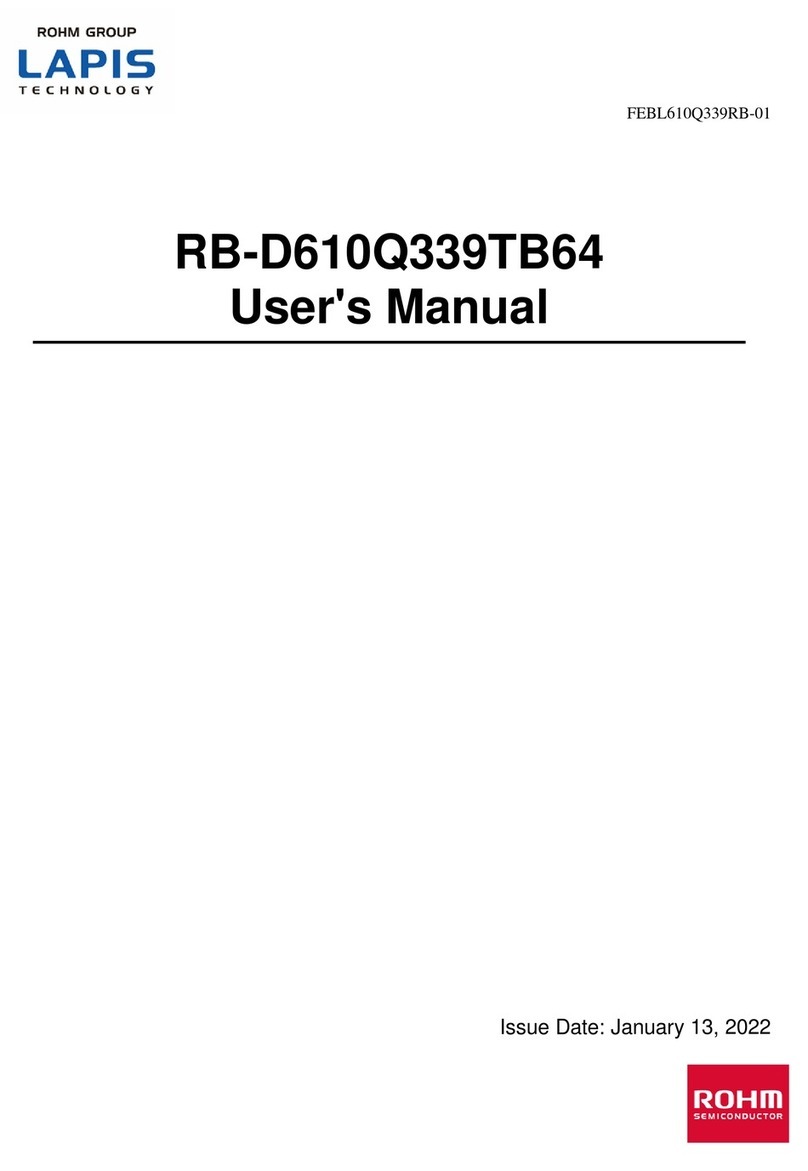
Rohm
Rohm LAPIS Technology RB-D610Q339TB64 User manual
Rohm
Rohm LAPIS Semiconductor ML620Q151B User manual
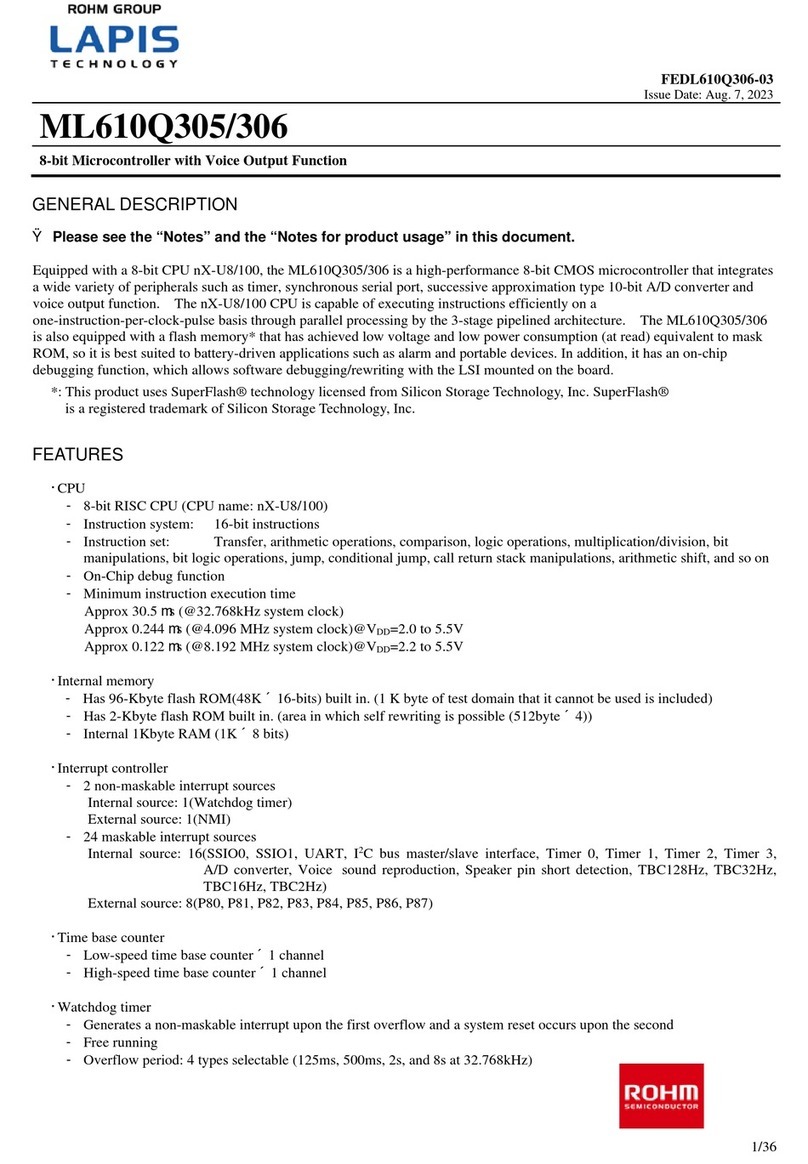
Rohm
Rohm LAPIS ML610Q305 User manual
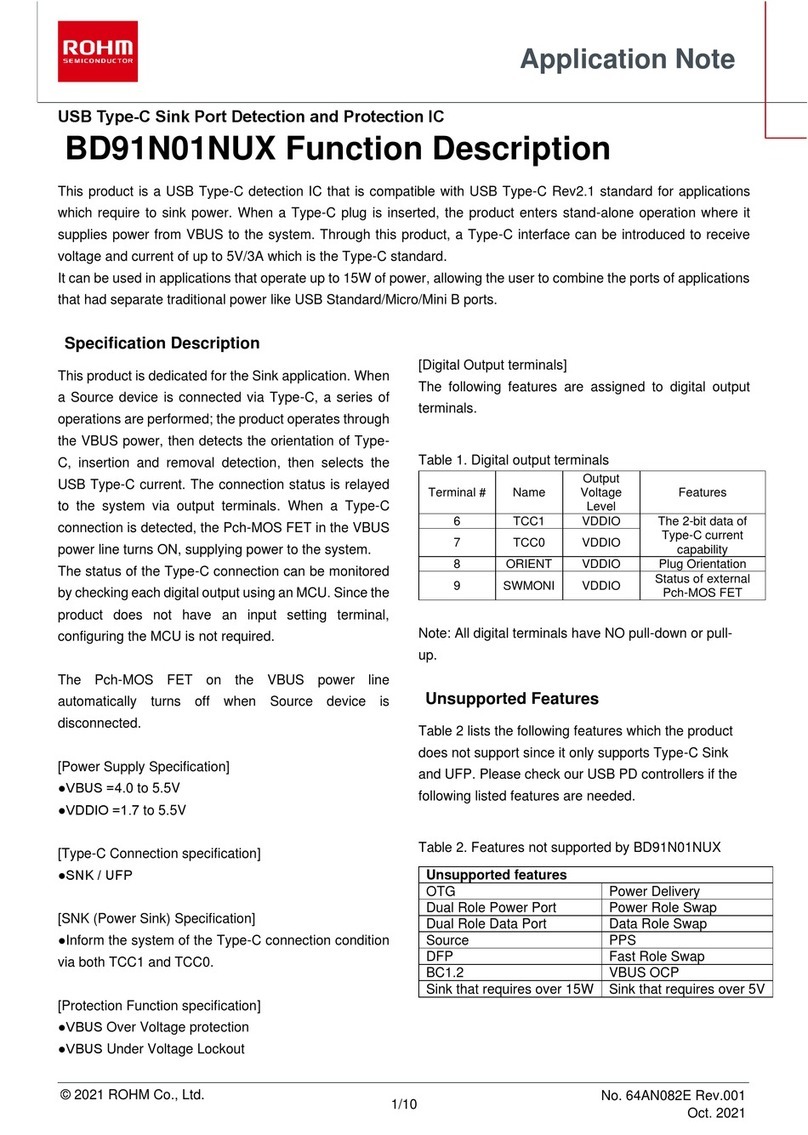
Rohm
Rohm BD91N01NUX Installation and operating instructions
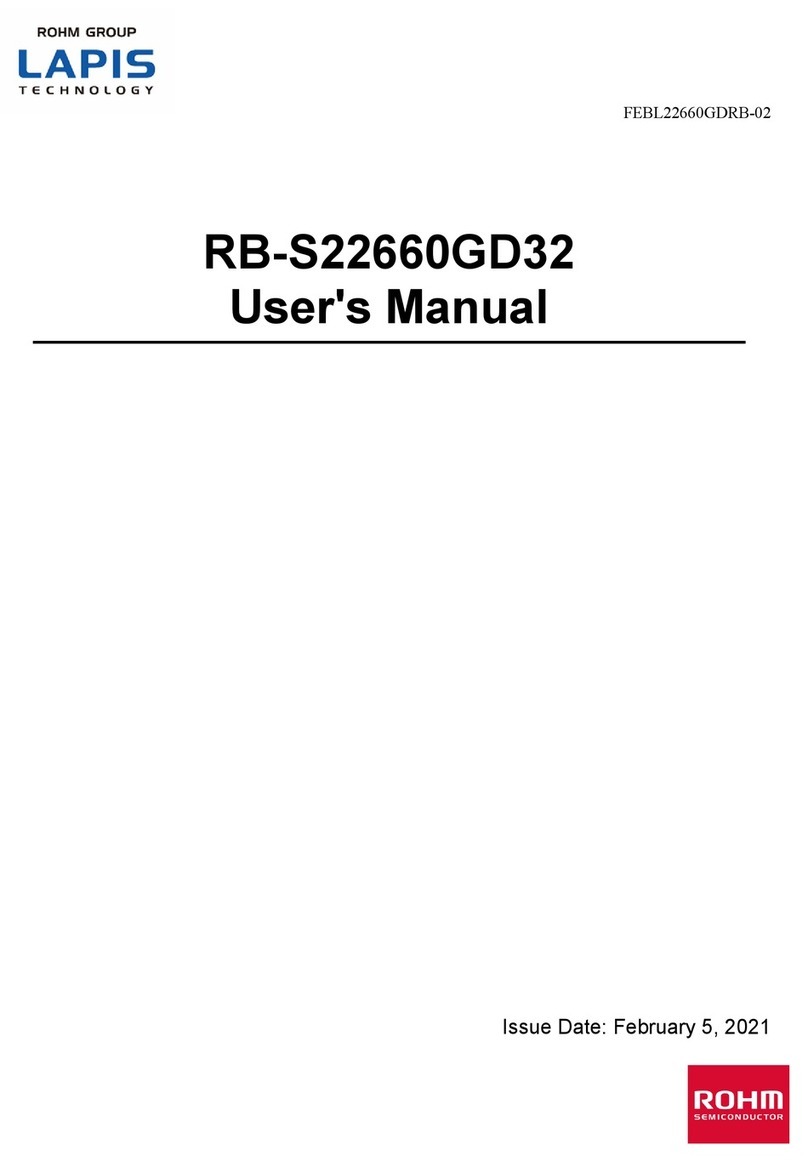
Rohm
Rohm LAPIS RB-S22660GD32 User manual

Rohm
Rohm RKX-EVK-001 User manual
Rohm
Rohm LAPIS SEMICONDUCTOR ML620Q503 User manual
Popular Microcontroller manuals by other brands
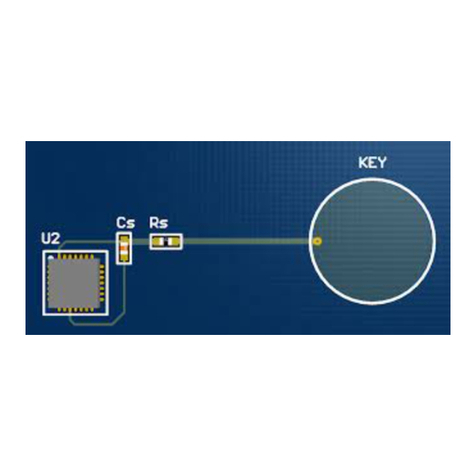
Atmel
Atmel QTouch Application note
Freescale Semiconductor
Freescale Semiconductor MPC5634M manual
Silicon Laboratories
Silicon Laboratories C8051F32x-DK user guide
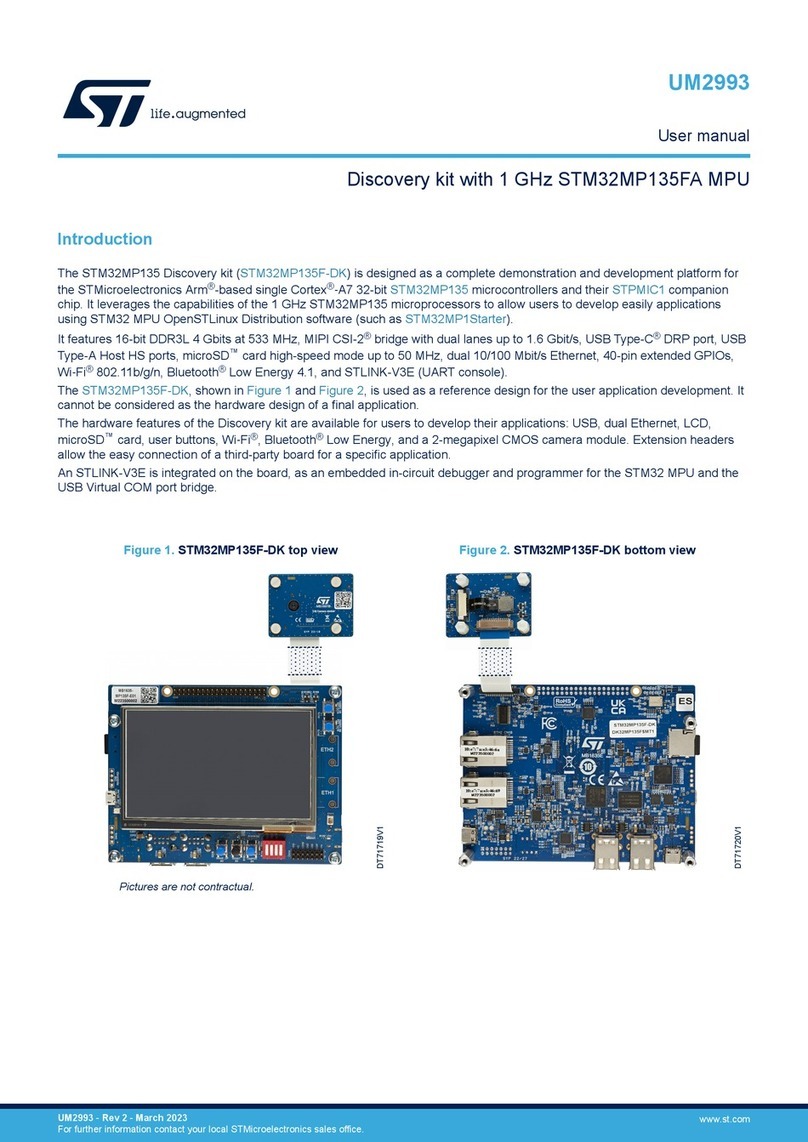
ST
ST STM32MP135F-DK user manual
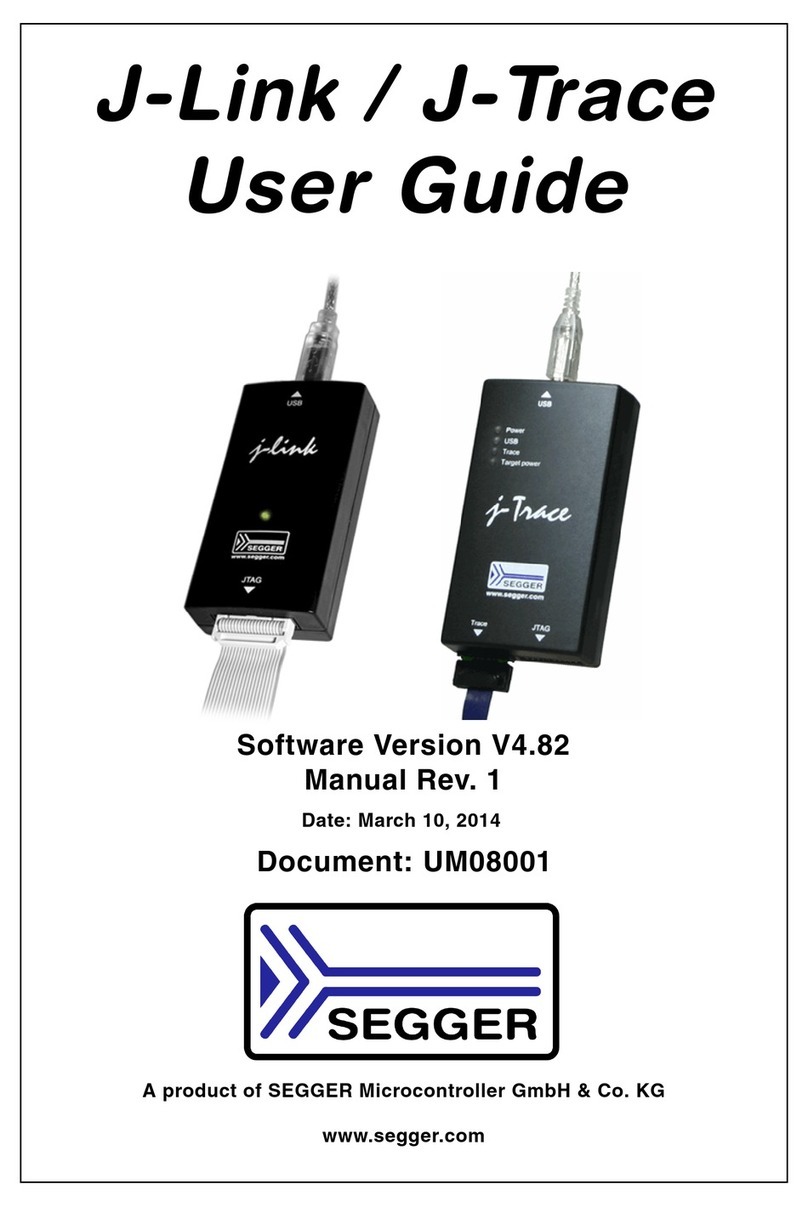
Segger
Segger J-Link user guide
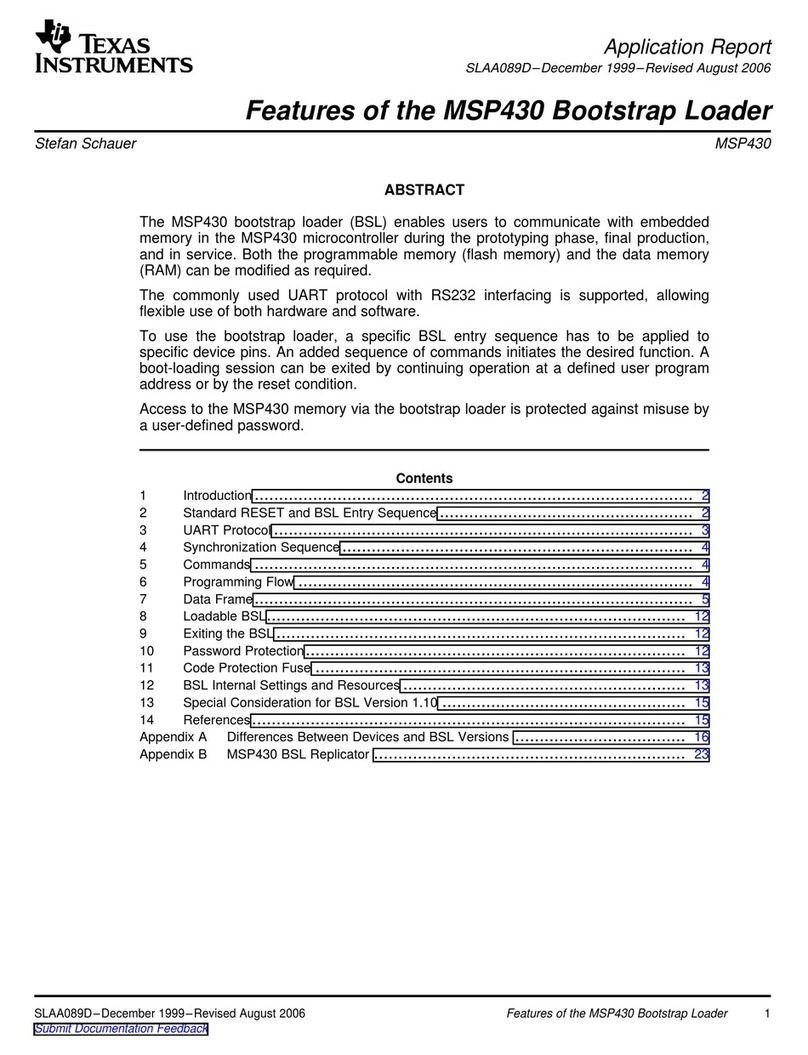
Texas Instruments
Texas Instruments Serial Programming Adapter MSP430 Application report

